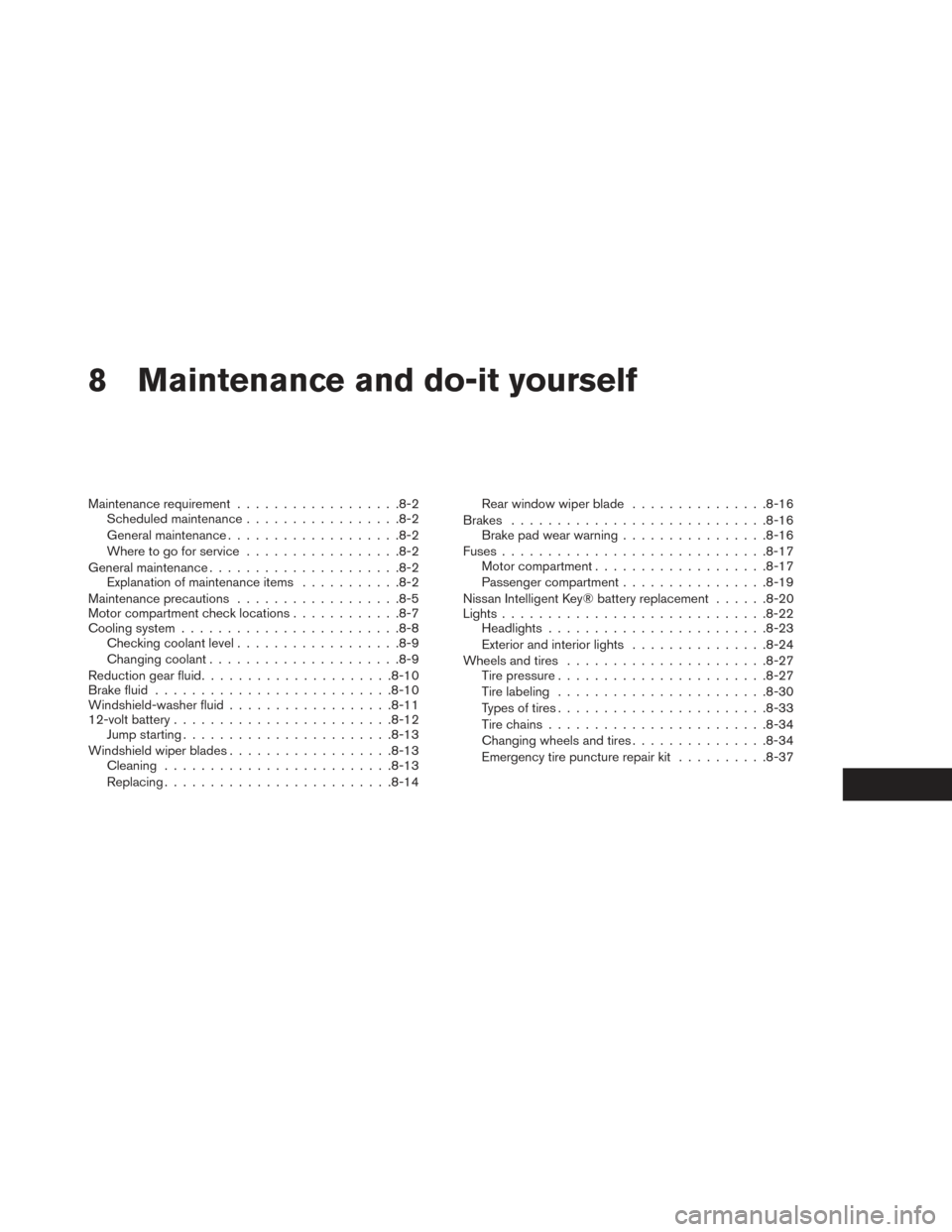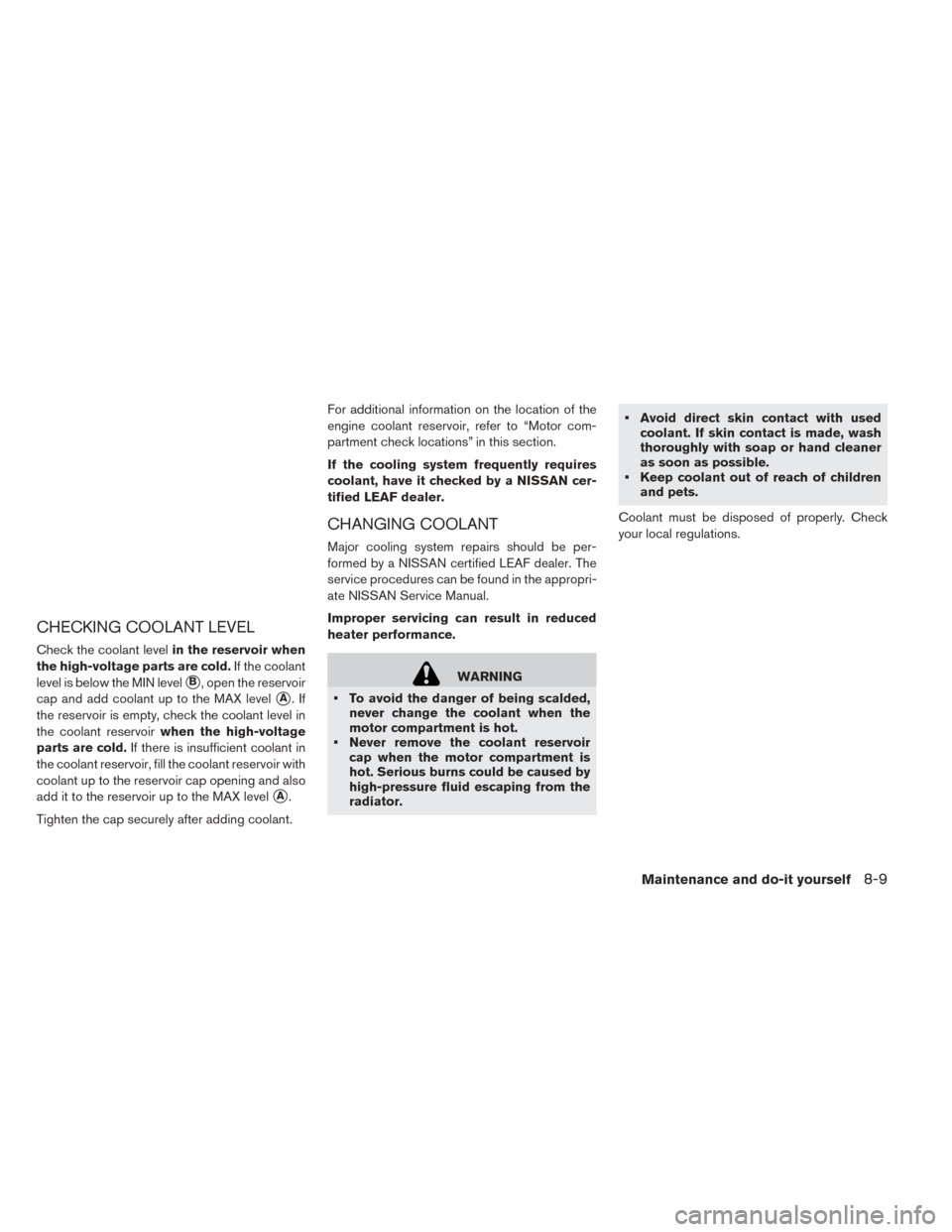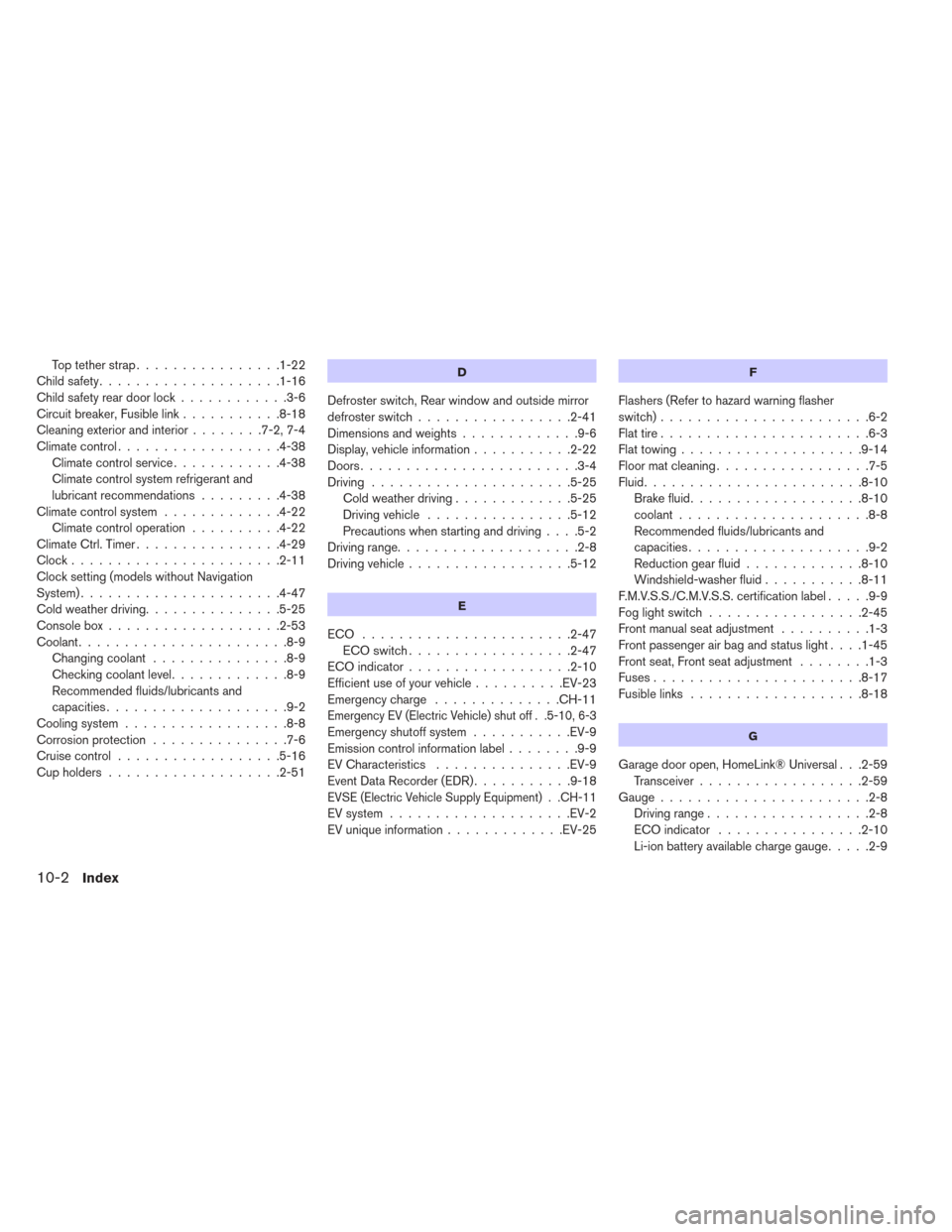Page 354 of 437

8 Maintenance and do-it yourself
Maintenance requirement................. .8-2
Scheduled maintenance ................ .8-2
General maintenance .................. .8-2
Where to go for service ................ .8-2
General maintenance .................... .8-2
Explanation of maintenance items ...........8-2
Maintenance precautions ................. .8-5
Motor compartment check locations ............8-7
Cooling system ....................... .8-8
Checking coolant level ................. .8-9
Changing coolant .................... .8-9
Reduction gear fluid .................... .8-10
Brake fluid ......................... .8-10
Windshield-washer fluid ................. .8-11
12-volt battery ....................... .8-12
Jump starting ...................... .8-13
Windshield wiper blades ................. .8-13
Cleaning ........................ .8-13
Replacing ........................ .8-14Rear window wiper blade
...............8-16
Brakes ........................... .8-16
Brake pad wear warning ................8-16
Fuses ............................ .8-17
Motor compartment .................. .8-17
Passenger compartment ................8-19
Nissan Intelligent Key® battery replacement ......8-20
Lights ............................ .8-22
Headlights ....................... .8-23
Exterior and interior lights ...............8-24
Wheels and tires ..................... .8-27
Tire pressure ...................... .8-27
Tire labeling ...................... .8-30
Types of tires ...................... .8-33
Tire chains .......................
.8-34
Changing
wheels and tires .............. .8-34
Emergency tire puncture repair kit ..........8-37
Page 362 of 437

CHECKING COOLANT LEVEL
Check the coolant levelin the reservoir when
the high-voltage parts are cold. If the coolant
level is below the MIN level
�B, open the reservoir
cap and add coolant up to the MAX level
�A.If
the reservoir is empty, check the coolant level in
the coolant reservoir when the high-voltage
parts are cold. If there is insufficient coolant in
the coolant reservoir, fill the coolant reservoir with
coolant up to the reservoir cap opening and also
add it to the reservoir up to the MAX level
�A.
Tighten the cap securely after adding coolant. For additional information on the location of the
engine coolant reservoir, refer to “Motor com-
partment check locations” in this section.
If the cooling system frequently requires
coolant, have it checked by a NISSAN cer-
tified LEAF dealer.
CHANGING COOLANT
Major cooling system repairs should be per-
formed by a NISSAN certified LEAF dealer. The
service procedures can be found in the appropri-
ate NISSAN Service Manual.
Improper servicing can result in reduced
heater performance.
WARNING
• To avoid the danger of being scalded, never change the coolant when the
motor compartment is hot.
• Never remove the coolant reservoir cap when the motor compartment is
hot. Serious burns could be caused by
high-pressure fluid escaping from the
radiator. • Avoid direct skin contact with used
coolant. If skin contact is made, wash
thoroughly with soap or hand cleaner
as soon as possible.
• Keep coolant out of reach of children and pets.
Coolant must be disposed of properly. Check
your local regulations.
Maintenance and do-it yourself8-9
Page 415 of 437

Top tether strap................1-22
Childsafety....................1-16
Child safety rear door lock ............3-6
Circuit breaker, Fusible link ...........8-18
Cleaning exterior and interior ........7-2,7-4
Climatecontrol..................4-38 Climate control service ............4-38
Climate control system refrigerant and
lubricant recommendations .........4-38
Climate control system .............4-22
Climate control operation ..........4-22
Climate Ctrl. Timer ................4-29
Clock.......................2-11
Clock setting (models without Navigation
System) ......................4-47
Cold weather driving ...............5-25
Consolebox...................2-53
Coolant.......................8-9 Changingcoolant ...............8-9
Checkingcoolantlevel.............8-9
Recommended fluids/lubricants and
capacities ....................9-2
Cooling system ..................8-8
Corrosionprotection ...............7-6
Cruisecontrol..................5-16
Cupholders...................2-51D
Defroster switch, Rear window and outside mirror
defroster switch .................2-41
Dimensionsandweights.............9-6
Display, vehicle information ...........2-22
Doors ........................3-4
Driving ......................5-25
Cold weather driving .............5-25
Driving vehicle ................5-12
Precautions when starting and driving ....5-2
Driving range ....................2-8
Driving vehicle ..................5-12
E
ECO .......................2-47
ECO switch ..................2-47
ECOindicator..................2-10
Efficient use of your vehicle ..........EV-23
Emergency charge ..............CH-11
Emergency EV (Electric Vehicle) shut off . .5-10, 6-3
Emergency shutoff system ...........EV-9
Emission control information label ........9-9
EV Characteristics ...............EV-9
Event Data Recorder (EDR) ...........9-18
EVSE (Electric Vehicle Supply Equipment) . .CH-11
EV system....................EV-2
EV unique information .............EV-25
F
Flashers (Refer to hazard warning flasher
switch).......................6-2
Flat tire .......................6-3
Flattowing....................9-14
Floormatcleaning.................7-5
Fluid ........................8-10
Brake fluid ...................8-10
coolant.....................8-8
Recommended fluids/lubricants and
capacities ....................9-2
Reduction gear fluid .............8-10
Windshield-washer fluid ...........8-11
F.M.V.S.S./C.M.V.S.S. certification label .....9-9
Foglightswitch .................2-45
Frontmanualseatadjustment ..........1-3
Front passenger air bag and status light ....1-45
Front seat, Front seat adjustment ........1-3
Fuses.......................8-17
Fusiblelinks ...................8-18
G
Garage door open, HomeLink® Universal . . .2-59 Transceiver ..................2-59
Gauge.......................2-8 Driving range ..................2-8
ECO indicator ................2-10
Li-ion battery available charge gauge .....2-9
10-2Index